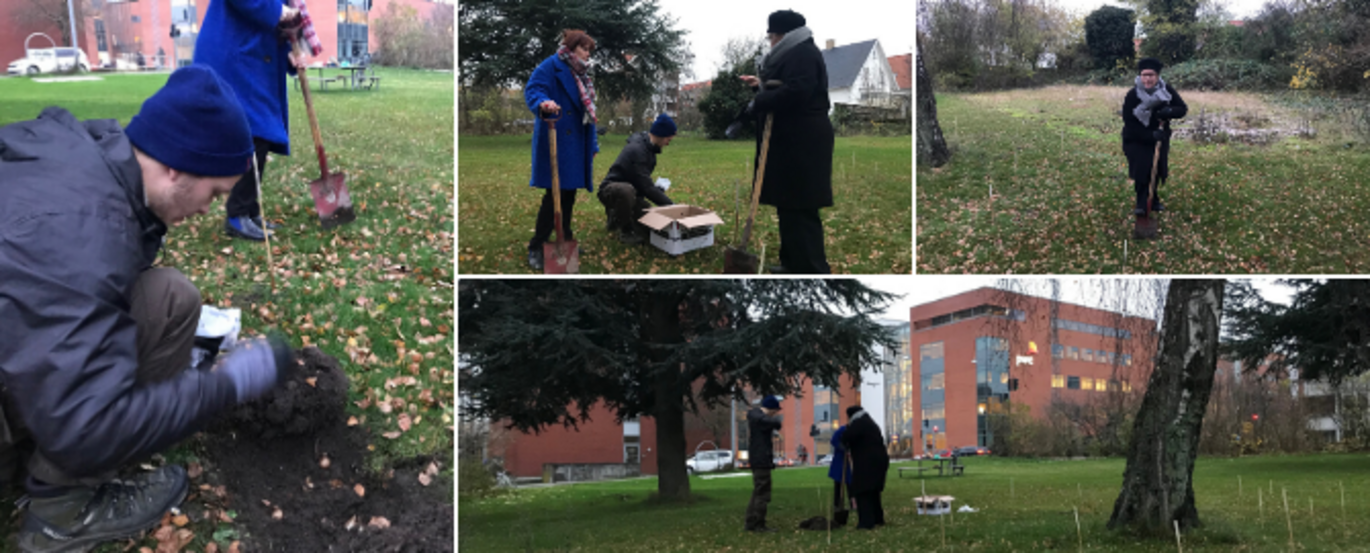AU Garden: Green visions, dirty fingernails and a carpet of flower bulbs
AU’s campus just got a new green oasis: AU Garden. AU Garden will bring employees and students together around growing things – from an organic kitchen garden to meadow beds of wildflowers and weeds.

AU Garden
The garden is located at the corner of Trøjborgvej and Nordre Ringgade and was previously known as Trøjborgplænen (the Trøjborg lawn).
All employees at students at AU with an interest in community gardening, biodiversity, nature and green communities can get involved in the project. A project group of AU employees and students has been formed – send a mail to sustainability@au.dk if you’re interested in joining.
The plot where AU Garden is located has been earmarked for the garden project until 2025, after which the project will be evaluated.
On 18 December from 3:30pm to 5:30 there will be a meeting of AU’s sustainability network. AU’s first climate accounts will be presented, along with a status update on the sustainability strategy and more information about AU Garden. All are welcome.
Read more on au.dk/sustainability or on Facebook.
”Join us for a fun planting party at AU’s new employee and student-run green playground!”
A few weeks ago, this invitation was posted on the FB page of AU’s sustainability network – a voluntary network for AU students and employees who share knowledge, ideas and inspiration for making AU greener and more sustainable.
A handful of members accepted, and over two gray, chilly afternoons in November, they got together to plant flower bulbs in plots marked out with bamboo stakes and twine in the new garden, which is located just across from Nobel Park on the corner of Trøjborgvej and Nordre Ringgade.
The wildest kitchen garden
One of the driving forces behind the garden is Lenore Messick, a language consultant in AU’s central administration, who’s also the chair of Greenshare Community Garden just across from Stakladen. She showed me around the garden, which at the moment basically consists of grass, a few trees and some bushes. But all this will change, she explained, pointing to a corner of the garden close to Nordre Ringgade that’s sheltered by a broad belt of shrubs.
READ MORE: Cultivating a sense of community in AU’s back garden
“There’s going to be the wildest kitchen garden here, with raised beds surrounded by chipped bark. It’s either going to be run communally by the group that volunteers to take care of it, or we’ll have individual plots assigned like we do at Greenshare. We haven’t figured this out yet. But people can grow vegetables, herbs or flowers for bouquets. And we’re going to plant berry bushes along the fence instead of nettles. We’re also going to have a compost area,” Lenore Messick explains.
Cultivated areas combined with areas where nature has the last word
She walks out onto the lawn, which dominates the garden right now like a thick green carpet.
“We’re going to let some of the grass grow wild and keep mowing the rest. Here in the middle of the garden, there’s going to be a circle of mown grass where there’ll be places to sit and maybe even a fire pit. The idea is to create a space that invites people to socialize,” she says.

Some of the members who are already involved in the kitchen garden project are students and postdocs from Agroecology and Food Science who are interested in putting theory into practice in a hands-on way. And there’s also a sandy spot where a group of biology students are going to sow native plants to give a variety of plants and animals a home in this small urban garden.
One of the biology students who’s involved in the garden is Lasse Dümke. And even though as a biologist he’s mostly interested in uncultivated nature and the biodiversity in natural ecosystems, he thinks the combination of more cultivated areas with areas where nature has the last word is a good idea.
“That’s a good mix, and if being able to use the space for gardening attracts other people than biologists, that’s fine with me.”
A volunteer project
The garden will be very much a volunteer project.
“AU’s gardeners will mow the grass and prune trees and bushes. But for everything else, we’re going to need volunteers to help with the work,” she says.
Lasse Dümke and Lenore Messick remove rectangles of turf from the lawn, lay flower bulbs under them and replace them carefully. A mix of crocuses, daffodils and narcissus.
“The crocuses will bloom in February, and then the other flowers will come in waves, so there’ll be flowers in the grass through May,” Lenore Messick says.
She hopes that AU Garden will become a meeting place for AU employees and students.
“You don’t have to drive outside town to find nature. Nature is right here where you are – even right next to Ringgaden.”

Translated by Lenore Messick
AU Garden
The garden is located at the corner of Trøjborgvej and Nordre Ringgade and was previously known as Trøjborgplænen (the Trøjborg lawn).
All employees at students at AU with an interest in community gardening, biodiversity, nature and green communities can get involved in the project. A project group of AU employees and students has been formed – send a mail to sustainability@au.dk if you’re interested in joining.
The plot where AU Garden is located has been earmarked for the garden project until 2025, after which the project will be evaluated.
On 18 December from 3:30pm to 5:30 there will be a meeting of AU’s sustainability network. AU’s first climate accounts will be presented, along with a status update on the sustainability strategy and more information about AU Garden. All are welcome.
Read more on au.dk/sustainability or on Facebook.

